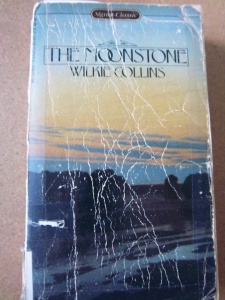I think The Moonstone may win as the longest book I’ve ever reread, as 482 pages (I’ll have to compare it to Goblet of Fire). As with most of the books I’m revisiting, I first read it in high school about ten years ago. I wanted a long, engaging book to keep with me during the long Saturday sessions of the club I volunteer with, and though I initially reached for The Woman in White, I decided this small pocket-sized book was a better choice. As it turns out, the only elements of the plot I remembered were the Indians and the quicksand, and of course the diamond.
 The Moonstone is the story of a large Yellow Diamond, first taken from a temple in India by a greedy British officer, and generations later stolen the very night it is removed from safekeeping and presented to Rachel Verinder on her birthday. It has everything you could want in a Victorian novel: a strong-willed heroine, a love triangle, large inheritances, good characters down on their luck, crime, intrigue, a quiet but persistent detective, ridiculous characters, suicide, disguises, marriage plans with secret motives, and hypnosis. I forgot how much I love this book!
The Moonstone is the story of a large Yellow Diamond, first taken from a temple in India by a greedy British officer, and generations later stolen the very night it is removed from safekeeping and presented to Rachel Verinder on her birthday. It has everything you could want in a Victorian novel: a strong-willed heroine, a love triangle, large inheritances, good characters down on their luck, crime, intrigue, a quiet but persistent detective, ridiculous characters, suicide, disguises, marriage plans with secret motives, and hypnosis. I forgot how much I love this book!
In some ways, having now read Bleak House, I can see how Collins and Dickens may have influenced each other’s work. Two characters in particular reminded me of Dicken’s deft caricatures. The steward Gabriel Betteredge treats Robinson Crusoe with a reverence usually reserved for the Bible, reading passages from it daily to glean what prophecies they may hold. Miss Clack is perfect as a sacrificially self-righteous gentlewoman, who sees it as her duty in life to push moral pamphlets and propaganda on others with missionary zeal. She takes herself so seriously that you can’t help but laugh at her. Inspector Bucket may or may not have been modeled after the good Sergeant Cuff, a patient, sympathetic, and intelligent investigator, depending on who first appeared in print.
One of the other main characters, Franklin Blake, is a distant cousin of Rachel’s and also a potential suitor. He is described as having a mixed heritage and upbringing, so that at different times his thought process will switch between “French” and “German” characteristics. It’s funny, in a way. Having studied literature and music a bit in college, I can identify distinguishing traits between different movements, little pockets of style and philosophy in past works, but it never seems to be something talked about in a modern perspective. We don’t compare current English literature to Italian output. Perhaps it’s because our society today is more global, or because we need a lens of history in order to properly analyze.
The book is structured as a series of first-person narratives passing from person to person as they are charged with chronicling the events surrounding the theft and recovery of the diamond. This makes the story simultaneously crisp and immediate in the action presented, and broad in time and scope.
I’m sure that I will read this a third time and some point in my life. With a book this long, it was wonderful to have forgotten many of the details and discover them again this time around. I have a nice hardcover copy, but I much prefer my beat-up library discard for carrying around with me. It looks like a book that is loved.
